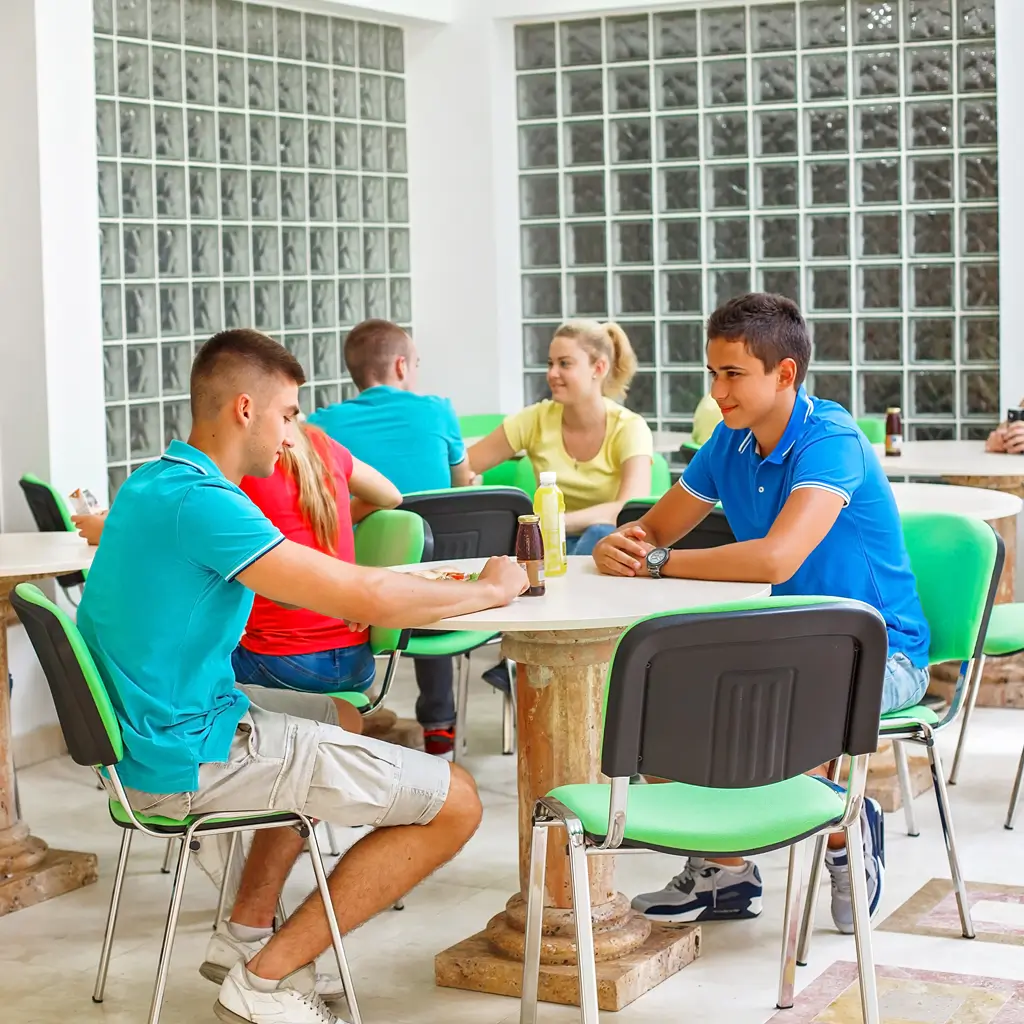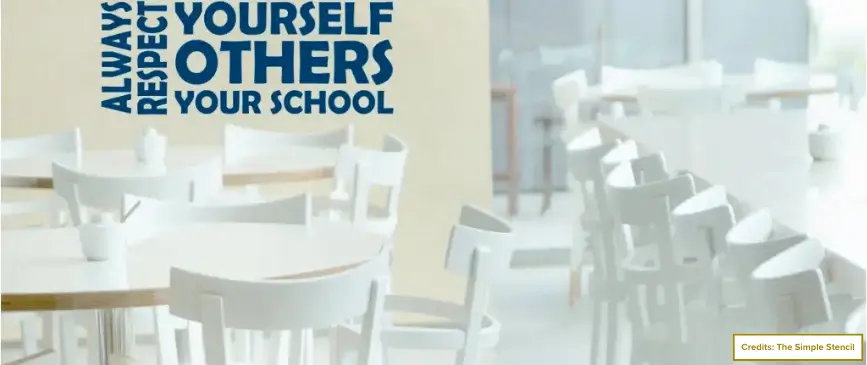Introduction
An inviting high school cafeteria is more than just a place to grab a meal. It’s a hub for students to refuel, socialize, and recharge. Transforming a school cafeteria into the best it can be is a journey that involves thoughtful planning and creative solutions.
This comprehensive guide will walk you through the essential steps to create the ultimate high school cafeteria experience. From layout design to menu choices, we’ll explore every aspect that contributes to developing a positive and enjoyable atmosphere for students.
So, without further ado, let’s find out how to build a cafeteria that satisfies hunger and nourishes the well-being of the entire school community.
Key Takeaways
Designing an Inviting Space
Focus on an efficient layout with an appealing aesthetic, comfortable and durable seating, and designated areas for different activities to create a positive and inclusive cafeteria environment.
Promoting Healthy Eating
Implement educational campaigns, provide a variety of tasty and healthy food options, and partner with local farms to emphasize the importance of nutrition.
Diverse and Allergy-Safe Menu
Offer a range of cuisines and dietary options, including seasonal items, while paying close attention to food allergens with clear labeling and staff training.
Engaging and Technologically Advanced
Incorporate interactive displays and modern technology like online ordering and cashless payments, and actively involve students in the cafeteria’s development and offerings.
How To Create The Best High School Cafeteria
It All Starts with a Great Cafeteria Design
At the heart of creating the best high school cafeteria lies the design – a thoughtful and efficient layout that caters to the diverse needs of students. Here, a critical consideration is the traffic flow to ensure students’ smooth and organized movement. This minimizes congestion and contributes to a more relaxed and enjoyable dining experience.
Dividing the cafeteria into different areas serves multiple purposes. The overall functionality is enhanced by designating specific spaces for food stations, seating, and trash disposal. Students can easily access their preferred food options, find a comfortable sitting place, and dispose of waste responsibly. This segregation of spaces adds to the overall efficiency of the cafeteria.
Visual appeal is another crucial aspect of cafeteria design. Choosing a layout that is not only functional but also aesthetically pleasing creates a positive atmosphere. Incorporating energetic colors and engaging decor transforms the cafeteria into a welcoming environment. This creates a space where students come for meals, socializing, and relaxation.
When it comes to seating, comfort and durability are crucial. Selecting seating options that provide comfort during meals and withstand the wear and tear of daily use ensures a long-lasting and enjoyable cafeteria experience. Additionally, offering a mix of seating arrangements caters to the varied preferences of students. Some may prefer traditional tables and chairs, while others may opt for cozy booths or communal spaces for group gatherings.
Therefore, the design of the high school cafeteria sets the stage for a positive and inclusive environment. It goes beyond functionality and incorporates aesthetics and comfort to create a space that enhances students’ overall high school experience.
| Component | Description |
| Layout | Efficient design facilitates smooth traffic flow, minimizes congestion, and enhances the dining experience. |
| Seating | Comfortable and durable seating arrangements, including traditional tables, cozy booths, and communal spaces. |
| Aesthetic Appeal | Energetic colors and engaging decor create a welcoming socializing and relaxation environment. |
| Functionality Zones | Designated areas for food stations, seating, and trash disposal to optimize cafeteria operations and student experience. |
Promote Healthy Eating
Creating and promoting healthy eating is about making good choices easy and appealing for students. It starts with educational campaigns that show why eating well matters. Using posters, presentations, and workshops, we can ensure students understand the importance of proper nutrition.
Workshops specifically focused on making healthy food choices bring practical knowledge to students. They learn how to pick foods that are good for them. Bringing in nutritionists adds expertise and gives students professional advice on making their meals balanced and nutritious.
But it’s not just about education; it’s also about making healthy options available. That’s why snack choices in the cafeteria should be good for health, tasty, and easy to grab.
You can partner with local farms to bring fresh organic produce to take things a step further. This act supports local farmers and also provides healthier options in the cafeteria. It’s a win-win, showing students the benefits of eating well while helping local agriculture.
Appealing Lunch Menu Options
Crafting an enticing cafeteria experience requires you to offer a menu that caters to varied tastes. By presenting a range of cuisines, the cafeteria becomes a place where students can explore different flavors and find something they enjoy.
Consideration of dietary preferences is also critical. Vegetarian and gluten-free options ensure all students have choices that suit their needs. This inclusivity caters to specific dietary requirements and, at the same time, also adds richness and diversity to the overall menu.
To make things even more exciting, introduce seasonal menu items. This aligns with fresh produce availability and adds a dynamic element to the cafeteria offerings. Most importantly, it keeps the menu exciting and encourages students to try new things.
Considering Food Allergens
Creating a safe and inclusive cafeteria means paying attention to food allergies. The first step to do that is clear labeling. Each food item should have information about common allergens to make it easy for students to know what they eat.
For students with allergies, information should be easily accessible. Whether it’s on a website, a poster, or available upon request, precise details about allergens help students make choices that keep them safe.
This is where training your staff to understand and handle food allergies ensures that they can provide accurate information and take necessary precautions. This training develops an environment where students feel confident in the safety of their meals.
Strategies for Promoting Healthy Eating in School Cafeterias
| Strategy | Description |
| Educational Campaigns | Utilizing posters, presentations, and workshops to inform students about the benefits and importance of healthy eating. |
| Diverse Healthy Options | Offering a variety of tasty, nutritious snacks and partnering with local farms for fresh produce. |
| Specialized Workshops | Bringing in nutritionists for expert advice and practical knowledge on making healthy food choices. |
| Allergen Awareness | Clear labeling of food items for allergens and staff training to ensure safety and inclusiveness. |
Making the Right Choice for Cafeteria Tables
Selecting the right tables for the cafeteria helps create a comfortable and functional space. It’s about finding a balance – tables that maximize seating without making the restaurant feel cramped. This means choosing tables with enough space for students to sit comfortably without overcrowding.
That’s where foldable or adjustable tables allow for versatile use of space. Whether rearranging for special events or creating more room during less busy times, these tables adapt to the cafeteria’s changing needs.
Also, ensure the tables you opt for are sturdy and easy-to-clean materials. The daily hustle and bustle can take a toll, so durability is crucial. Tables that are easy to clean ensure a hygienic environment and contribute to the overall well-being of the cafeteria.
And regular maintenance is the secret to longevity. Keeping tables in good condition extends their lifespan and maintains a polished and inviting cafeteria atmosphere. It’s a simple yet effective way to ensure that the choice of cafeteria tables continues to serve the needs of both students and staff.
Interactive Displays
Engaging students goes beyond just serving meals. And incorporating displays that promote nutritional awareness is a great way to achieve this. These displays can highlight where certain foods come from and their benefits. It adds an educational element to the cafeteria and transforms it into a space where students learn about the food they eat.
Digital screens displaying daily menus and nutritional information take things a step further. It provides quick and accessible information for students to make informed meal choices. Knowing what’s on the menu and its nutritional value empowers students to make healthier decisions.
But interaction is a two-way street. Allowing students to provide feedback through these displays creates a sense of involvement. Their opinions matter, whether it’s about the food, the ambiance, or any suggestions they may have. This enhances the cafeteria experience and develops a sense of community where everyone’s voice is heard.
Technology Integration
Well, there are multiple ways to integrate technology. One way is through online ordering, which adds efficiency to the process.
Cashless payment systems are another tech-savvy move. No more fumbling for cash – students can pay with cards or apps, which makes transactions quick and hassle-free. It’s a small change that adds a lot of convenience.
You can also invest in modern kitchen equipment to speed up food preparation and ensure students get their meals promptly. This crucial step improves efficiency and also contributes to a positive cafeteria experience.
Lastly, using technology to monitor and manage inventory is a wise decision. It helps track what’s available, reduce waste, and ensure that popular items are always in stock. It’s a tech-driven way to keep the cafeteria running smoothly.
Student Involvement
Creating a cafeteria that feels like a student-friendly space requires the students’ active involvement. One way to achieve that is by establishing committees where students have a say in what goes on the menu.
To understand their preferences, gathering feedback through surveys is key. What do students like? What would they change? Surveys help get direct input and make it easier to shape the cafeteria experience based on what students want.
Furthermore, events like theme days or food tastings add a fun touch to student involvement. It’s a chance for students to explore new foods and have a say in what might become a regular part of the menu.
Encouraging students to be part of cafeteria-related initiatives creates a sense of ownership. Whether suggesting new ideas or volunteering during events, involving students adds vibrant energy to the cafeteria and makes it a place that truly belongs to them.
Conclusion
And there you have it!
Wondering how could this be implemented perfectly? Leave it to us. Because that’s what we’ve been doing for years. Just to give a glimpse of what your school can achieve with ICC, look at some of our work, achievements, and behind-the-scenes on Instagram.
Feel free to get in touch with us to discuss your cafeteria project. We’ll make sure to do some phenomenal work to simply exceed your expectations.



